Introduction
Mr. Chairman, Representative Cooper, distinguished members of the Committee, thank you for the opportunity to appear today to testify on Russian compliance with the Intermediate-Range Nuclear Forces (INF) Treaty and how the United States should respond if it is determined that Russia has violated the treaty.
The 1987 INF Treaty is a landmark arms control agreement, which banned an entire class of U.S. and Soviet land-based ballistic and cruise missiles. It enhanced U.S. security by prohibiting Soviet missiles, particularly the multiple-warhead SS-20, which threatened U.S. allies in Europe and Asia, while banning the U.S. Pershing II and ground-launched cruise missiles that Moscow feared.
Recently, questions have arisen about Russia—a successor state to the Soviet Union—and its compliance with the treaty. Assertions that the RS-26 ballistic missile violates the treaty appear to have no basis. The reported R-500 cruise missile appears to be of more serious concern, but there is little hard information in open sources about it.
A Russian violation of the INF Treaty would be a serious matter and should be treated as such, as should any treaty violation. If Russia is producing, testing and/or deploying new INF missiles, such weapons would—depending on range and deployment location—pose a threat to U.S. allies in Europe and Asia, as well as other states, such as China. They would also threaten U.S. forward-deployed forces. Unless deployed in northeastern Russia, such missiles would not have the range to threaten the United States.
Maintaining the INF Treaty remains in the interest of the United States. America’s allies greatly value the agreement. If the U.S. government were to conclude that Russia has violated the treaty, it should press Russia to end the violation and come back into full compliance. In addition to raising this issue with Moscow in senior diplomatic and treaty channels, Washington should brief Russia’s neighbors, both in Europe and Asia, on what it knows about the violation. U.S. officials should encourage countries that would be in range of Russian missiles to make their concerns known directly to Moscow.
If Russia has violated the INF Treaty, the United States should continue to observe the treaty’s terms, at least for the near term. U.S. withdrawal from the treaty would free Russia from any legal obligation to observe the treaty’s limits, and would bring no apparent advantage for the United States.
While continuing to observe a treaty that another party is violating may seem counter-intuitive, this is what the Reagan administration did during the 1980s following the discovery of the Krasnoyarsk large phased-array radar, a violation of the 1972 Anti-Ballistic Missile (ABM) Treaty. The Reagan administration pressed the Soviets on the violation, but continued to observe the ABM treaty and simultaneously negotiated new arms control agreements, including the INF Treaty. In 1990, the Soviets agreed to dismantle the Krasnoyarsk radar.
The INF Treaty
President Ronald Reagan and General Secretary Mikhail Gorbachev signed the Intermediate-Range Nuclear Forces Treaty in December 1987. The negotiations, which began in 1981, proved an arduous process. The Soviets walked out of the talks in November 1983, following the arrival in Europe of U.S. INF missiles—the Pershing II ballistic missile and the ground-launched cruise missile (GLCM).
Negotiations resumed in 1985. Moscow first sought an agreement that would ban U.S. INF missiles from Europe while allowing Soviet missiles to remain. The Soviets later proposed an agreement that would ban INF missiles from Europe but allow their deployment elsewhere. The U.S. government sought global limits; given the mobility and range of Soviet INF missiles such as the triple-warhead SS-20, those missiles could threaten Europe even from east of the Urals, and could be moved west. Washington was also sensitive to the concerns of U.S. allies in Asia, such as Japan and South Korea, who did not want the agreement to afford them lesser protection than Europe.
In the end, the Soviets agreed to the U.S. “zero-zero” proposal to eliminate all U.S. and Soviet INF missiles. Two factors appear to account for this. First, the Soviet military had great concerns about U.S. INF missiles in Europe, particularly the Pershing II. Second, Mr. Gorbachev concluded that the Soviet Union could not afford nuclear overkill when it resulted in a greater nuclear threat to the Soviet Union, especially at a time when the Soviet economy was under significant stress.
The INF Treaty required that the United States and Soviet Union each eliminate all of their land-based ballistic and cruise missiles with ranges between 500 and 5500 kilometers (300-3400 miles).[1] The treaty makes no distinction between nuclear- and conventionally-armed missiles. All U.S. and Soviet land-based missiles of INF range were banned, as was the production, testing and deployment of new INF missiles. The treaty contained provisions for data exchanges and what were the most intrusive verification measures of any nuclear arms agreement, including on-site inspections.
The INF Treaty entered into force in June 1988. It required that all INF missiles and launchers, and certain associated equipment, be eliminated within three years. The treaty resulted in the elimination of 846 American GLCM, Pershing II and Pershing I missiles, and 1846 Soviet SS-20, SS-4, SS-5, SS-12, SS-23 and SSC-X-4 missiles, along with their launchers and associated equipment. The eliminations were accomplished by June 1991.
The treaty is of indefinite duration. When the Soviet Union collapsed in December 1991, six successor states to the USSR—Russia plus Belarus, Kazakhstan, Turkmenistan, Ukraine and Uzbekistan—had INF facilities on their territory. The six states agreed to assume the Soviet Union’s INF Treaty obligations.
Russia, Kazakhstan, Belarus and Ukraine furthermore agreed to participate in the Special Verification Commission—the implementation body established by the INF Treaty—and signed a memorandum formalizing that arrangement. Among other things, those four states then agreed among themselves on issues such as how to divide up the inspections of U.S. INF facilities (the treaty permitted inspections of facilities and former facilities for 13 years after entry into force, i.e., until 2001). Turkmenistan and Uzbekistan each had only a single eliminated INF facility and chose not to participate in the Special Verification Commission or inspections.
Russian Concerns about the Treaty
Beginning in 2005, some Russian officials began to express concern that the INF Treaty banned only the United States and Russia (plus Belarus, Kazakhstan and Ukraine) from having INF missiles, while other countries were free to deploy them. They suggested that Russia should consider withdrawing from the treaty, in some cases pointing to the 2001 U.S. decision to withdraw from the ABM Treaty (which it did in 2002).
In 2005, Russian media reported that Defense Minister Sergei Ivanov had asked Secretary of Defense Donald Rumsfeld about his views regarding Russia’s potential withdrawal from the INF Treaty. In 2006, Mr. Ivanov called the INF Treaty a relic of the Cold War. In February 2007, he asserted that Russia was much weaker because of the treaty, and shortly thereafter President Vladimir Putin proposed that the United States and Russia re-examine the treaty in light of other states’ development of intermediate-range missiles. In October 2007, Mr. Putin proposed that the INF Treaty become multilateral—a global ban on INF missiles. Later that month, at the UN General Assembly, U.S. and Russian officials jointly affirmed their adherence to the treaty and called on other states to eliminate their INF missiles.
Russia has also tied INF Treaty compliance to other issues. In 2007, Chief of the General Staff Yuri Baluyevsky said that Russia’s decision regarding withdrawal from the treaty would depend on U.S. actions regarding missile defense in Europe. Recent Russian statements have been more moderate, with a focus on extending the treaty to other states. In May 2012, Chief of the General Staff Nikolai Makarov ruled out withdrawal.
The issue of third-country INF missiles has clearly been a far greater concern for Russia than for the United States. The reason is straightforward. Ten countries deployed or were developing ballistic or cruise missiles with ranges between 500 and 5500 kilometers as of 2012: China, Egypt, India, Iran, Israel, North Korea, Pakistan, Saudi Arabia, South Korea and Syria.[2] None of these countries currently has an intermediate-range ballistic or cruise missile that could reach the United States. Many of these countries, however, possess or are developing intermediate-range missiles that can reach Russian territory.
Questions about Russia’s Compliance with the INF Treaty
Two charges have emerged publicly regarding Russia’s violations of the INF Treaty. One was related to the RS-26 ballistic missile, which has been test flown to ranges below and greater than 5500 kilometers. There is some specific information in open sources about this. In May 2012, Russia flew the missile from Plesetsk to Kura, a distance of 5800 kilometers. Then, for two subsequent tests, Russia changed the weapon’s payload—outfitting it with multiple warheads—and flew it just 2000 kilometers.[3]
The claim of an INF Treaty violation focuses on the fact that Russia tested the RS-26 at ranges less than 5500 kilometers. But according to the 2010 New Strategic Arms Reduction Treaty (New START), as well as the 1991 START I Treaty, a land-based ballistic missile “with a range in excess of 5500 kilometers” is an intercontinental ballistic missile (ICBM), which is a permitted missile that is limited by the New START Treaty. The INF Treaty bans land-based ballistic missiles with ranges “in excess of 500 kilometers” but “not in excess of 5500 kilometers.” By these definitions, the RS-26 is a permitted ICBM, not a prohibited intermediate-range ballistic missile.
Some have argued that the Russians tested the RS-26 to an ICBM range to ensure that it would be “legal,” while actually intending to aim it at targets at intermediate ranges. While that may be true, it would not constitute a treaty violation.
The use of ICBMs at less than intercontinental ranges has always been possible. The INF Treaty required the Soviet Union to destroy more than 600 SS-20 intermediate-range ballistic missiles, capable of carrying 1800 nuclear warheads, which could have rapidly hit targets throughout Europe and Asia. When U.S. officials assessed how the Soviets, without the SS-20, would strike time-urgent targets, such as European airbases hosting U.S. nuclear weapons and dual-capable aircraft, they concluded that the Soviets would allocate some ICBMs to the mission, flying them at less than intercontinental range. The Reagan administration understood and fully accepted that possibility.
Since the missile has been tested to a range greater than 5500 kilometers, any deployed RS-26 ballistic missiles would count as deployed ICBMs and be limited under New START. Unless based in Russia’s northeastern region or on the Kola Peninsula, those missiles could not reach U.S. territory (and, even then, only a part of U.S. territory). Yet each deployed RS-26 missile and each deployed RS-26 warhead would count under New START’s limits of 700 deployed strategic missiles and bombers, and 1550 deployed strategic warheads, possibly displacing ICBMs and ICBM warheads that could target all of the United States.
The alleged Russian cruise missile violation of the INF Treaty appears to be a different story. Unfortunately, open sources provide little hard information about the missile, its range or other characteristics other than that Russia may have tested an intermediate-range cruise missile, often referred to as the R-500.
According to a New York Times article, on January 17, 2014, U.S. officials briefed their NATO counterparts on U.S. concerns that Russia, beginning in 2008, had conducted flight tests of a cruise missile (presumably the R-500) with a range that would make it subject to and prohibited under the INF Treaty. The story reported that U.S. officials had raised the missile tests with Russian officials but had not received a satisfactory response, though the Obama administration had not yet reached a determination about whether to declare the tests a violation of the treaty.[4]
Principal Deputy Assistant Secretary of State for Nuclear and Strategic Policy Anita Friedt confirmed in April that the U.S. government was concerned about Russia’s compliance with the INF Treaty and had raised the issue with Russia and NATO allies. Ms. Friedt did not offer details regarding the compliance concern.[5]
Russian media has provided some reports on the development of the R-500, beginning as early as 2007. Some of these sources indicated that the flight range of the new missile could exceed 500 kilometers, which would appear to constitute a violation of the INF Treaty. Some more recent reports by Russian journalists and arms experts suggest that the R-500 might be able to fly as far as 3000 kilometers.
I do not have access to classified information regarding the R-500 cruise missile or the U.S. government’s particular compliance concern. I know from my time in government that the process of reaching compliance judgments is often difficult and time-consuming, particularly if there is incomplete information about the activity in question.
The State Department is preparing its annual compliance report for Congress, which will presumably address the R-500 issue. The report could state that the R-500 cruise missile is a violation of the INF Treaty, or that the question is still under review. At this point in time, in the unclassified world, we do not know whether the U.S. government has rendered a judgment on this question.
The following discussion is speculative, as it is based on an assumption that the U.S. government has concluded or will conclude that Russia has violated the INF Treaty by producing, testing or deploying the R-500 cruise missile. Absent concrete information about the missile or the U.S. government’s determination regarding a possible INF Treaty violation, any discussion of the U.S. policy response will invariably be hypothetical.
The Importance of Treaty Compliance
If Russia has violated the INF Treaty, that is a matter of serious concern on several levels.
First, when signing and ratifying an arms control or other treaty, a state takes on legal commitments. As a general rule of international law, that state is obliged to adhere to those commitments. The U.S. government should treat any treaty violation as a serious concern in and of itself.
Second, Russia’s illegal seizure of Crimea violated Russia’s legal commitments under the United Nations Charter and its political commitments under the Helsinki Final Act and Budapest Memorandum on Security Assurances. If Russia has also violated the INF Treaty, that suggests a disturbing pattern of disregard for international agreements. That should concern other countries, including those who are party to the UN Charter and Helsinki Final Act as well as the United States.
Third, a Russian violation of the INF Treaty would have security consequences. Those consequences would depend first on the nature of the violation—whether the missile has just been tested or whether it has also been deployed. The latter, of course, has more serious security consequences. Those consequences would also depend on questions such as the number, range and capabilities of the missile. As noted, there is little hard information in open sources regarding the R-500. That makes it difficult to assess the specific security consequences of Russia’s alleged activity.
As a general proposition, deployed Russian intermediate-range missiles would pose a greater direct threat to U.S. allies in Europe and Asia than to the United States itself. That is because, unless deployed in the northeastern portion of Russia, those missiles could not reach U.S. territory. For example, when the Soviets deployed their SS-20 missile, deployment sites were scattered from the western Soviet Union to Drovyanaya, located about 300 kilometers east of Lake Baikal in Siberia. The SS-20’s range (5000 kilometers) put it at the high end of the 500-5500 kilometer range band. From its deployment sites, the only U.S. territory that SS-20s with a 5000-kilometer range could reach was part of Alaska. However, the SS-20s could hold at risk all of NATO Europe, Japan and South Korea, as well as China, much of South Asia, the Middle East and northern Africa. Of course, U.S. forces deployed on the territory of European and Asian allies within range of Russian INF missiles were directly threatened.
A new INF missile with a range less than the 5000-kilometer SS-20 would cover fewer of Russia’s neighbors. In all probability, it would not be able to reach the United States.
The security concern for the United States thus would be driven primarily by the threat that these missiles would pose to NATO members, Japan and South Korea, countries with which the United States has treaty relationships. Those allies would most likely be concerned by the deployment of a new Russian intermediate-range missile, particularly if armed with a nuclear warhead. Thus far, there appear to have been no public expressions of concern by U.S. allies. Although NATO and some other allies have been briefed on U.S. concerns about the R-500, they may still have limited information and/or are awaiting a U.S. judgment regarding the missile’s compliance with the INF Treaty.
A related security concern would be the incentive that such Russian INF missiles might give to third countries to increase their own nuclear offensive capabilities in response. China, in particular, comes to mind. Again, the direct threat in such a case would likely to be to U.S. regional allies.
Fourth, a Russian decision to violate the INF Treaty would not bode well for further U.S.-Russian efforts to reduce nuclear arms beyond the limits of New START. Negotiating a new agreement while the other party is violating an existing agreement is difficult (though Washington has done so in the past; see below). In any case, even absent the question of an INF Treaty violation, Washington’s efforts to negotiate further nuclear arms reductions with Russia have not been reciprocated over the past two years.
If Russia Has Violated the INF Treaty, How Should the United States Respond?
If the U.S. government has concluded or does conclude that Russia has violated the INF Treaty with the R-500 cruise missile, what steps should it take to address its concerns? The response should be shaped in part by the severity of the violation. Testing of an INF missile in violation of the treaty would be problematic, but not as serious as deployment of INF missiles. Several actions would be advisable in the near term.
First, the administration should use appropriate opportunities in diplomatic channels, including meetings at the cabinet/ministerial-level, to raise the R-500 cruise missile question with Russian officials and press them to terminate the program or otherwise resolve U.S. concerns and come back into full compliance with the treaty.
Second, the administration should contact Russia, Belarus, Kazakhstan and Ukraine and convene a meeting of the Special Verification Commission, established by the INF Treaty in part as a venue for addressing INF compliance issues. That body has not met for a number of years. Now would appear to be an appropriate time to convene it, to discuss the R-500 question.
Third, U.S. officials should brief NATO allies, Asian allies (particularly Japan and South Korea) and other interested countries, including China and India, about the R-500 and U.S. concerns and share as much information as possible. It does not appear the R-500 would be able to reach much, if any, of the United States. It would, however, pose a direct threat to countries in Europe and Asia. The administration should provide those countries with information to let them raise their concerns with Moscow. Washington should do what it can to make this an issue between the Russian government and its neighbors—the states that would be directly threatened.
Fourth, the Pentagon could consider devoting a small budget to a feasibility study on possible new U.S. intermediate-range missiles. Given budget pressures and the current lack of a defined priority military requirement, there would be little sense in proceeding to develop or acquire such missiles. However, the prospect of a future Pershing III or advanced ground-launched cruise missile might get Russia’s attention and remind Moscow of the value of the INF Treaty.
Continuing to Observe the Treaty
While pursuing these steps, it would be in the U.S. interest to continue to observe the INF Treaty. Although at some later date it might be appropriate to consider withdrawal, particularly if Russia were deploying INF missiles, at this point there are sound reasons for not doing so.
First, unless U.S. officials can offer convincing evidence of a Russian treaty violation—no easy task, especially considering that “sources and methods” issues will argue to keep information classified—Washington could be seen as responsible for ending the treaty. Moscow would certainly prefer that Washington initiate withdrawal and take the heat for ending the treaty, and it would do everything in its power to place the blame squarely on the United States.
Second, a U.S. withdrawal that ended the treaty would leave Russia free to test, produce and deploy INF missiles without constraint. That would raise concern on the part of U.S. allies.
Third, at present, the Pentagon has no plans for land-based intermediate-range ballistic or cruise missiles. So a U.S. withdrawal from the treaty would leave Russia free to deploy missiles for which the United States has no counterpart.
Developing new U.S. intermediate-range missiles would take time and would impose a new burden on an already stretched Pentagon budget. As the prospects for an increase in the defense budget appear minimal, funding an expensive new intermediate-range missile would mean drawing funds from other defense accounts, such as the modernization of strategic nuclear forces, missile defense or new conventional weapons systems. Absent a specific, priority military requirement for intermediate-range missiles, this would not appear to be a wise use of resources.
Fourth, even if the United States were to build intermediate-range missiles, where would it deploy them? Those missiles would pose a serious response to a Russian treaty violation only if deployed in Europe, Japan or South Korea. That does not seem feasible.
U.S. deployment of INF missiles (Pershing IIs and GLCMs) to Europe in the 1980s was a key factor in motivating Moscow to agree to ban intermediate-range missiles. But deployment in Europe was by no means guaranteed; in the end, it proved a close thing.
Indeed, NATO officials worried that some of the five European basing countries would be unable to accept the U.S. missiles due to the depth of domestic political and public opposition. Ambassador Paul Nitze, the U.S. INF negotiator from 1981-83, took his “walk in the woods” with his Soviet counterpart in 1981 and suggested an agreement that differed from the official U.S. negotiating position. A major consideration behind his doing so was his fear that NATO would not be able to deploy Pershing IIs or GLCMs—and that the resulting fall-out would tear the Alliance apart.
Few who went through the INF deployment process would relish the chance to do so again. It is not clear that any NATO members would be eager to host such missiles. Those most likely to offer would be in Central Europe. Deployment there, however, would put the missiles in places where they would be exposed to a preemptive strike. Such deployments would also be hugely provocative to Moscow—and would probably be opposed by some NATO members.
The United States would likely find no takers for its intermediate-range missiles in Asia, either. Japan would worry about the effect of such deployments on its effort to improve its relationship with Russia and, in any case, would not accept nuclear-armed missiles. South Korea is building its own missiles to hold targets in North Korea at risk and would fear that deployment of U.S. missiles might disrupt its warming relations with China.
Deploying intermediate-range missiles in the continental United States would make little sense, as they could only hold targets in the Western Hemisphere at risk. Placing missiles with ranges toward the high end of 500-5500 kilometers in Alaska or Guam would allow some coverage of the Russian Far East (a missile in Guam would need a range of at least 3200 kilometers to reach Russian territory), but those locations would raise other considerations.
It thus would make sense for now for the United States to continue to abide by the INF Treaty even if questions linger about Russian compliance or there were a conclusion that Russia had violated the treaty. The United States also should continue to observe other arms control agreements. By public accounts, Russia continues to meet its obligations under the New START Treaty, despite tensions between Washington and Moscow over Russia’s annexation of Crimea and support for Ukrainian separatists. Continued implementation of New START is in the U.S. national interest: it reduces the nuclear threat to the United States while providing important transparency and predictability regarding Russian strategic offensive forces.
Previous administrations have observed arms control agreements, even in the face of outright treaty violations by Moscow.
Take the Reagan administration. The 1972 Anti-Ballistic Missile (ABM) Treaty and its 1974 protocol limited the United States and Soviet Union each to one ABM interceptor deployment area. In order to ensure that large phased-array radars (LPARs) located outside deployment areas would be used for permitted early warning purposes but not for battle management (i.e., guiding interceptors to their targets), the treaty required that LPARs outside of the deployment areas be located on the periphery of a country’s territory and oriented outward.
In 1983, the U.S. intelligence community detected construction of an LPAR at Krasnoyarsk in central Siberia. The radar was more than 800 kilometers (500 miles) from the Russian-Mongolian border and, instead of being oriented outward—i.e., toward the south—it faced to the east, over a broad expanse of Russian territory.
The Reagan administration judged that the radar constituted a violation of the ABM Treaty. U.S. officials raised the radar at the fall 1983 session of the Standing Consultative Commission, the body established by the ABM Treaty to address, among other issues, questions about treaty compliance.
The Soviets asserted that the Krasnoyarsk LPAR would be used for space-tracking purposes, an implausible claim given that few space orbits would pass through the radar’s field of view. However, the LPAR did have an excellent view of the attack corridor for U.S. submarine-launched ballistic missiles flying out of the northern Pacific Ocean to targets in the central Soviet Union. The radar plugged a gap in the Soviets’ early warning radar coverage; to gain the same early warning coverage without violating the ABM Treaty, the Soviets would have had to build two LPARs in the Soviet Far East.
A January 1984 White House report to Congress assessed that the Krasnoyarsk LPAR “constitutes a violation of legal obligations under the Anti-Ballistic Missile Treaty of 1972 in that in its associated siting, orientation and capability, it is prohibited by this Treaty.” U.S. officials continued to press the Soviets on the radar.
The Reagan administration later considered declaring the radar a “material breach” of the ABM Treaty, a term that would have provided stronger grounds for withdrawal from the treaty. But Washington did not withdraw.
In 1989, the Soviets conceded that the radar was a “technical” violation of the ABM Treaty in that its location was inconsistent with the treaty’s requirements. They argued that the radar was for early warning purposes (likely true, though that did not make the radar compliant with the letter of the treaty). In 1990, the Soviets agreed to dismantle the radar—seven years after the U.S. intelligence community first detected it.
Over the seven years between the discovery of the Krasnoyarsk radar and the Soviet decision to dismantle it, the Reagan and George H. W. Bush administrations continued to observe the ABM Treaty, even as they raised their concerns about the radar. They also continued to observe other arms control agreements. The Reagan administration, which considered the 1979 Strategic Arms Limitation Treaty II (SALT II) “fatally flawed,” observed a policy of not undercutting that unratified treaty until late 1986.
Moreover, the Reagan administration also continued to negotiate new nuclear arms control agreements with the Soviets. The Reagan administration concluded the INF Treaty in 1987. It made major progress on the START I Treaty, reaching agreement on the levels of strategic forces to be allowed each side. The George H. W. Bush administration completed START I in 1991.
Multilateralizing the INF Treaty
The Russians in the past have proposed to multilateralize the INF Treaty, an objective that the United States endorsed in 2007, though U.S. officials did not thereafter press in diplomatic channels to achieve that goal. To be sure, a global ban on INF missiles—if agreed and implemented—would eliminate missiles from the arsenals of countries of concern or potential concern to the United States, such as Iran, North Korea and Syria. It would also, however, remove intermediate-range missiles from the arsenals of U.S. friends and allies, such as Israel and South Korea.
At present, there appears to be no serious prospect of achieving such a global ban on intermediate-range missiles. Undoubtedly recognizing this, the Russians, who originated the idea of such an agreement, have done virtually nothing to seek to broaden the INF Treaty’s participation.
Conclusion
Mr. Chairman, Representative Cooper, members of the Committee,
If the U.S. government has concluded or were to conclude that Russia has violated the INF Treaty, it would be a matter of serious concern. In such an event, U.S. officials should press the Russians in diplomatic channels, including via senior-level engagement and in the Special Verification Commission, to end the violation and return to full compliance. U.S. officials should brief U.S. allies in Europe and Asia, as well as other countries that would be interested, such as China. The objective should be to multilateralize the issue, that is, to have other countries—the ones that would be most directly threatened by a Russian INF missile—press Moscow as well.
For the near term, it would be in the U.S. interest to continue observing the INF Treaty. U.S. allies likely would support that course. It would deny Russia a situation in which it could test, produce and deploy INF missiles without constraint. The United States has no plans to build intermediate-range missiles. Even if it did wish to do so, it has no apparent place to deploy such missiles as a response to a Russian treaty violation.
Continuing to observe the INF Treaty while pressing the compliance issue with Russia makes sense, at least for the foreseeable future. This does not mean that, if Russia has wantonly violated the treaty, the United States should continue to observe it indefinitely. But, for now, there is no compelling U.S. interest in withdrawal.
Thank you for your attention.
[1] The treaty distinguishes between “intermediate-range” missiles, with ranges of 1000-5500 kilometers, and “shorter-range” missiles, with ranges of 500-1000 kilometers. The treaty bans both classes of missiles. The term “intermediate-range” is often used to describe both classes of missiles, spanning the range of 500-5500 kilometers, and is used in that meaning for the rest of this statement.
[2] Six other countries—Germany, Poland, Hungary, the Czech Republic, Slovakia and Bulgaria—had INF missiles (Pershing Is and SS-23s) but eliminated them during the 15 years after the INF Treaty was signed, even though they were not parties to the treaty.
[3] Jeffrey Lewis, “An Intercontinental Ballistic Missile by any Other Name,” Foreign Policy, April 25, 2014, http://www.foreignpolicy.com/articles/2014/04/25/nuclear_semantics_russia_inf_treaty_missiles_icbm.
[4] Michael Gordon, “U.S. Says Russia Tested Missile, Despite Treaty,” The New York Times, January 29, 2014.
[5] Testimony of Acting Assistant Secretary of State Anita E. Friedt before the House Committee on Foreign Affairs, April 29, 2014, http://docs.house.gov/meetings/FA/FA18/20140429/102163/HHRG-113-FA18-Wstate-FriedtA-20140429.PDF.
The Brookings Institution is committed to quality, independence, and impact.
We are supported by a diverse array of funders. In line with our values and policies, each Brookings publication represents the sole views of its author(s).
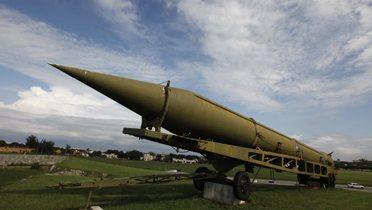
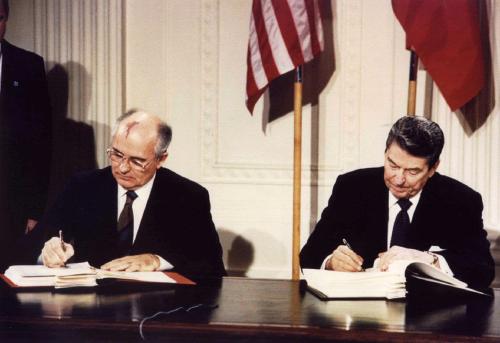
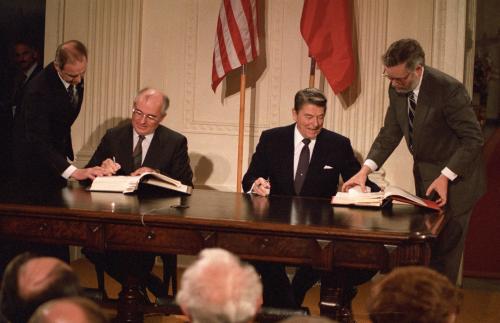
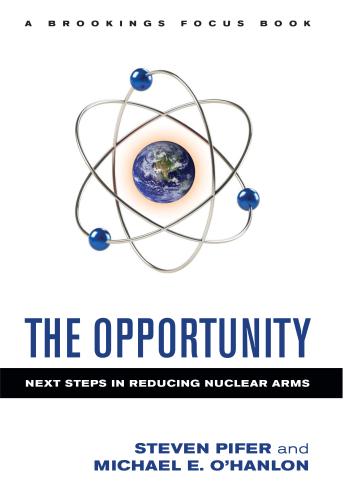
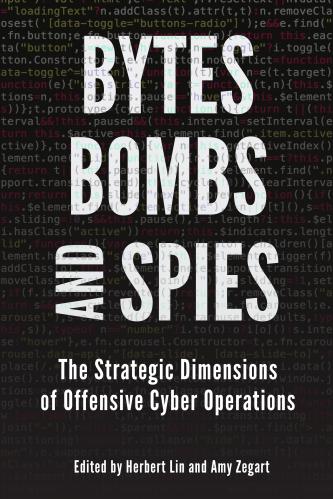



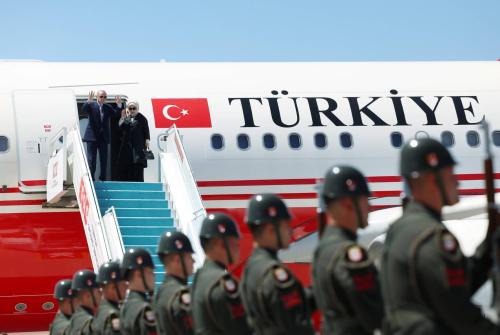
Commentary
TestimonyThe INF Treaty, Russian Compliance and the U.S. Policy Response
July 17, 2014